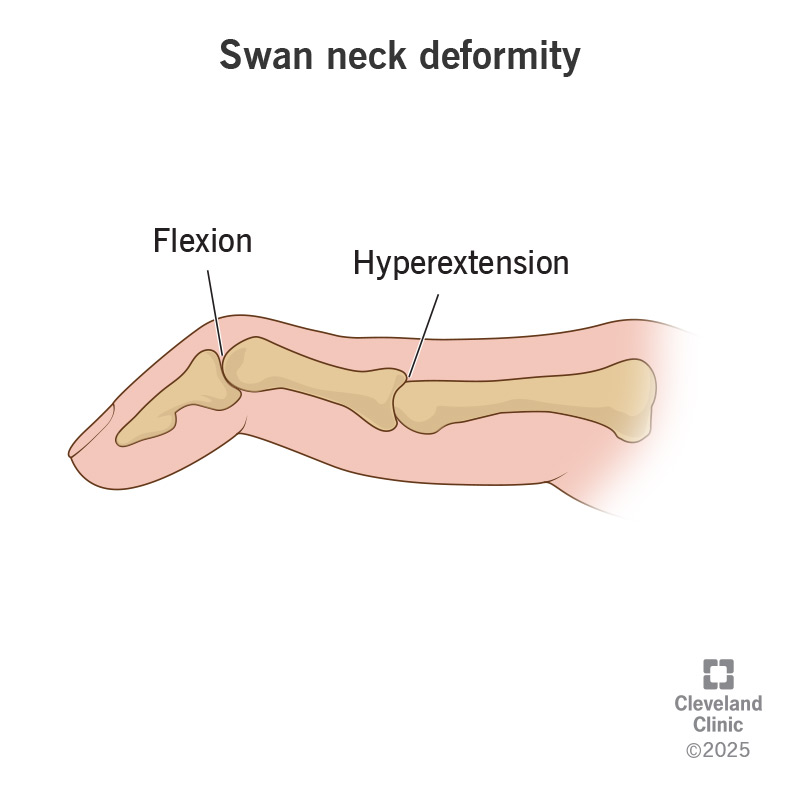Swan neck deformity can affect one finger or all your fingers. It causes the different joints in your finger to bend different ways, forming an “S” shape. Injuries and diseases that damage tendons and ligaments in your fingers can cause it.
Advertisement
Cleveland Clinic is a non-profit academic medical center. Advertising on our site helps support our mission. We do not endorse non-Cleveland Clinic products or services. Policy

Swan neck deformity affects the tendons and joints in your finger, making them bend in a shape that resembles a swan’s neck. The joint at the tip of your finger bends forward (flexes), while the middle joint bends backward (hyperextends).
Advertisement
Cleveland Clinic is a non-profit academic medical center. Advertising on our site helps support our mission. We do not endorse non-Cleveland Clinic products or services. Policy
Swan neck deformity is the reverse of boutonniere deformity. That’s where your middle knuckle bends forward (flexes) and the joint at the tip of your finger bends backward (hyperextends). Damage to the many different tendons in your finger can change the delicate balance of the forces that pull on your joints, making them bend in different ways.
Most people with swan neck deformity develop it from an inflammatory condition, like rheumatoid arthritis. But others may develop it after an injury. Some people with neurologic disorders can also develop swan neck deformity.
The primary symptom of swan neck deformity is the abnormal bending of your finger joints. When you have this deformity, your finger or fingers hold this position at rest. Over time, the condition may worsen. You may find it more difficult to straighten or bend your affected fingers and may have difficulty using your hand.
You can recognize swan neck deformity by the characteristic “S” shape of your finger.
Other possible symptoms of swan neck deformity include:
Advertisement
Various diseases and conditions can lead to swan neck deformity, including:
Finger joint deformities happen when something damages the intricate mechanics inside your finger that bend and straighten your joints. Healthcare providers call this the “extensor mechanism.” It’s a complex network of tendons and muscles that act like levers and pulleys on your different finger joints.
Because these parts all work together and balance each other, damage to any part will affect all the joints in your finger differently. A lack of force pulling one way on one joint can cause too much pulling another way on another joint. Swan neck deformity often starts with one joint, and then, the others follow.
It can happen if:
Healthcare providers diagnose swan neck deformity by examining your finger or fingers. They’ll test the joints to see how much they can bend or extend and how stiff they are. They’ll also ask about your health history and any chronic conditions or injuries that might have contributed to the deformity.
Tests might include:
Healthcare providers often try to correct swan neck deformity with hand therapy and splinting. A hand therapist can provide different types of finger splints to gradually correct the different joints. They’ll also give you gentle finger exercises to practice.
If your joints are very stiff or you have an injury that needs repair, you might need surgery. Your surgeon might need to release some tissues and repair others. Or they might move your tendons around in an effort to rebalance the forces on your finger joints. After surgery, you’ll need to wear a splint and follow up with hand therapy.
Advertisement
Treatment can often improve swan neck deformity and restore some mobility to your finger. It works better when the deformity is still in the early stages and you haven’t had it for too long. Even so, you might not be able to correct it completely, even with surgery. If you have a chronic condition that causes it, it might cause it again.
Whether you have conservative treatment or surgery, hand therapy will be important to your long-term recovery. This is especially true if you have an underlying condition that contributes to swan neck deformity. Keeping up with your hand therapy after treatment will give you the best chance of a favorable outcome.
Treating swan neck deformity often depends on treating the condition that causes it. This can be complex, depending on the condition. While surgery might repair a one-time injury, chronic conditions like rheumatoid arthritis need lifetime treatment.
Your healthcare provider will do their best to manage the various factors that contribute to swan neck deformity. They’ll try to prevent it from worsening or returning. They’ll also advise you on what you can do at home to keep your fingers as mobile and functional as possible, even though they may still look a little different.
Advertisement
Last reviewed on 02/18/2025.
Learn more about the Health Library and our editorial process.